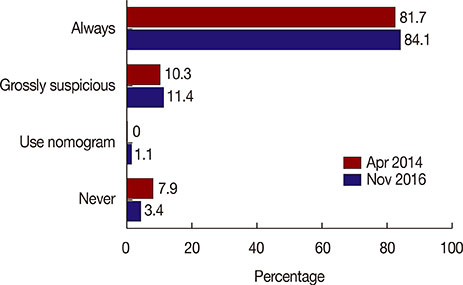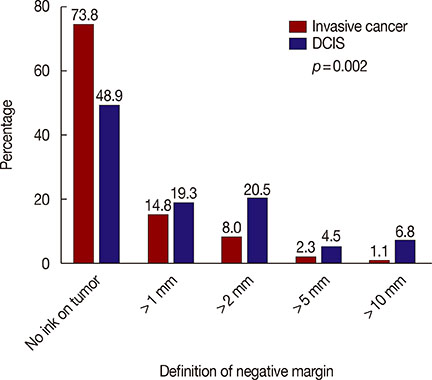J Breast Cancer.
2017 Dec;20(4):400-403. 10.4048/jbc.2017.20.4.400.
The Practice Patterns and Perceptions of Korean Surgeons Regarding Margin Status after Breast-Conserving Surgery
- Affiliations
-
- 1Department of Surgery, Seoul St. Mary's Hospital, The Catholic University of Korea College of Medicine, Seoul, Korea.
- 2Department of Surgery, Daerim St. Mary's Hospital, Seoul, Korea. brcakorea@gmail.com
- 3Department of Surgery, Seoul National University Bundang Hospital, Seoul National University College of Medicine, Seongnam, Korea.
- 4Department of Surgery, Gangnam Severance Hospital, Yonsei University College of Medicine, Seoul, Korea.
- 5Department of Surgery, Seoul Metropolitan Government Seoul National University Boramae Medical Center, Seoul, Korea.
- 6Department of Surgery, CHA Bundang Medical Center, CHA University, Seongnam, Korea.
- 7Department of Surgery, Korea University Guro Hospital, Seoul, Korea.
- 8Department of Surgery, Myongji Hospital, Seonam University College of Medicine, Goyang, Korea.
- 9Department of Surgery, Chungbuk National University College of Medicine, Cheongju, Korea.
- 10Department of Surgery, Gyeongsang National University Changwon Hospital, Gyeongsang National University School of Medicine, Changwon, Korea.
- 11Department of Surgery, Dankook University College of Medicine, Cheonan, Korea.
- 12Department of Surgery, International St. Mary's Hospital, Catholic Kwandong University, Incheon, Korea.
- KMID: 2398211
- DOI: http://doi.org/10.4048/jbc.2017.20.4.400
Abstract
- Two consecutive surveys for breast surgeons in Korea were conducted to comprehend the practice patterns and perceptions on margin status after breast-conserving surgery. The surveys were conducted online in 2014 (initial) and 2016 (follow-up). A total of 126 and 88 responses were obtained in the initial and follow-up survey, respectively. More than 80% of the respondents replied to routinely apply frozen section biopsy for intraoperative margin assessment in both surveys. Re-excision recommendations of the margin for invasive cancer significantly changed from a close margin to a positive margin over time (p=0.033). Most of the respondents (73.8%) defined a negative margin as "no ink on tumor" in invasive cancer, whereas more diverse responses were observed in ductal carcinoma in situ cases. The influence of guideline establishment for negative margins has been identified. A high uptake rate of intraoperative frozen section biopsy was noted and routine use needs reconsideration.
MeSH Terms
Figure
Reference
-
1. Buchholz TA, Somerfield MR, Griggs JJ, El-Eid S, Hammond ME, Lyman GH, et al. Margins for breast-conserving surgery with whole-breast irradiation in stage I and II invasive breast cancer: American Society of Clinical Oncology endorsement of the Society of Surgical Oncology/American Society for Radiation Oncology consensus guideline. J Clin Oncol. 2014; 32:1502–1506.
Article2. Morrow M, Van Zee KJ, Solin LJ, Houssami N, Chavez-MacGregor M, Harris JR, et al. Society of Surgical Oncology-American Society for Radiation Oncology-American Society of Clinical Oncology consensus guideline on margins for breast-conserving surgery with whole-breast irradiation in ductal carcinoma in situ. J Clin Oncol. 2016; 34:4040–4046.
Article3. Meric F, Mirza NQ, Vlastos G, Buchholz TA, Kuerer HM, Babiera GV, et al. Positive surgical margins and ipsilateral breast tumor recurrence predict disease-specific survival after breast-conserving therapy. Cancer. 2003; 97:926–933.
Article4. St John ER, Al-Khudairi R, Ashrafian H, Athanasiou T, Takats Z, Hadjiminas DJ, et al. Diagnostic accuracy of intraoperative techniques for margin assessment in breast cancer surgery: a meta-analysis. Ann Surg. 2017; 265:300–310.
Article5. DeSnyder SM, Hunt KK, Smith BD, Moran MS, Klimberg S, Lucci A. Assessment of practice patterns following publication of the SSO-ASTRO consensus guideline on margins for breast-conserving therapy in stage I and II invasive breast cancer. Ann Surg Oncol. 2015; 22:3250–3256.
Article6. Parvez E, Hodgson N, Cornacchi SD, Ramsaroop A, Gordon M, Farrokhyar F, et al. Survey of American and Canadian general surgeons’ perceptions of margin status and practice patterns for breast conserving surgery. Breast J. 2014; 20:481–488.
Article7. Taghian A, Mohiuddin M, Jagsi R, Goldberg S, Ceilley E, Powell S. Current perceptions regarding surgical margin status after breast-conserving therapy: results of a survey. Ann Surg. 2005; 241:629–639.
Article8. Blair SL, Thompson K, Rococco J, Malcarne V, Beitsch PD, Ollila DW. Attaining negative margins in breast-conservation operations: is there a consensus among breast surgeons? J Am Coll Surg. 2009; 209:608–613.
Article9. Yun YH, Kim YA, Min YH, Park S, Won YJ, Kim DY, et al. The influence of hospital volume and surgical treatment delay on long-term survival after cancer surgery. Ann Oncol. 2012; 23:2731–2737.
Article10. Boughey JC, Hieken TJ, Jakub JW, Degnim AC, Grant CS, Farley DR, et al. Impact of analysis of frozen-section margin on reoperation rates in women undergoing lumpectomy for breast cancer: evaluation of the National Surgical Quality Improvement Program data. Surgery. 2014; 156:190–197.
Article11. Jorns JM, Visscher D, Sabel M, Breslin T, Healy P, Daignaut S, et al. Intraoperative frozen section analysis of margins in breast conserving surgery significantly decreases reoperative rates: one-year experience at an ambulatory surgical center. Am J Clin Pathol. 2012; 138:657–669.
Article12. National Comprehensive Cancer Network. Clinical practice guidelines in oncology: breast cancer. Accessed May 4th, 2017. https://www.nccn.org/professionals/physician_gls/default.aspx.
- Full Text Links
- Actions
-
Cited
- CITED
-
- Close
- Share
- Similar articles
-
- Multiple Margin Positivity of Frozen Section Is an Independent Risk Factor for Local Recurrence in Breast-Conserving Surgery
- Atypical Hyperplasia at the Margin of Frozen Sections from Breast-Conserving Surgery
- The Safety and Cosmetic Effect of Immediate Latissimus Dorsi Flap Reconstruction after Breast Conserving Surgery
- Intraoperative Specimen Mammography for Margin Assessment in Breast-Conserving Surgery
- Comparison of Psychiatric Symptoms between Total Mastectomy and Breast Conserving Surgery in Breast Cancer Patients



